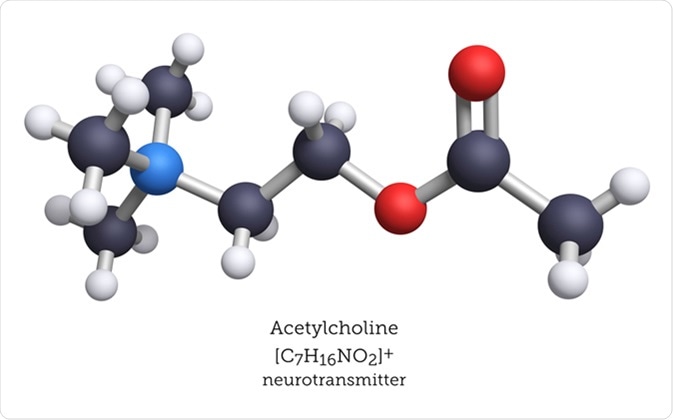Skip to:
What is Acetylcholine?
Acetylcholine (Ach) is a neurotransmitter that functions in both the central and peripheral nervous systems. It is a non-monoamine subtype, meaning that it does not contain an amino group connected to an aromatic ring by a carbon chain (which is common to the neurotransmitters of the noradrenergic, serotonergic, and dopaminergic systems). Instead, it is made up of two chemical groups: choline and acetyl coenzyme A (AcCoA).
Choline is an essential nutrient present in soy, egg yolks, and meat, and is classified within the B-complex group of vitamins. The precursor to choline, AcCoA, is derived from glucose. The synthesis of this neurotransmitter, then, is dependent on adequate consumption of choline; insufficiency can be combatted by taking a choline supplement, usually in the form of lecithin.

Acetylcholine is a neurotransmitter released by nerve cells to send signals to other types of cells. Primarily, acetylcholine is associated with motor neurons and the activation of muscle function. Image Credit: Molecular Arts / Shutterstock
How does Acetylcholine work?
ACh is present in both vertebrates and invertebrates and together with adrenaline and noradrenaline (NA), it is the principal effector of the autonomic nervous system – the largely unconscious arm of the peripheral nervous system, which regulates the internal organs, controlling visceral functions.
ACh additionally functions in the CNS where it affects cellular and synaptic physiology to influence networks, resulting in behavioural shifts such as sleeping to wakefulness and distraction to attention.
2-Minute Neuroscience: Acetylcholine
How is Acetylcholine produced?
Acetylcholine is produced in the nerve endings of cholinergic neurons by the enzyme choline acetyltransferase (ChAT).
The action of ChAT is the slowest step in the process of signal transduction and is therefore referred to as rate-limiting. It is the availabilities of both acetyl-CoA and choline that determine ACh synthesis.
The diet-derived choline is taken up by cholinergic neurons via choline uptake transporter (ChT) where is combines with acetyl molecules produced from the metabolism of glucose. Here, it builds up in the synaptic terminal where it recombines with acetyl molecules.
ACh is transported into the end of neurons (synaptic vesicles) for storage until release by the vesicular acetylcholine transporter (VAChT). Acetylcholine signalling is stimulated by calcium influx into the synaptic terminal caused by an action potential.
The synaptic terminal is a specialised region within the axon of the presynaptic cell – the cell that contains ACh.
ACh is released from the presynaptic neuron into the junction between two neurons, called the synaptic cleft. The diffusion of ACh across this space results in its arrival at the next neuron, the postsynaptic neuron, perpetuating the signal along the pathway. Here, ACh will bind to and activate the receptors here, producing the postsynaptic response necessary to further the nerve impulse.
Neurotransmitters must be removed from the synapse before another signal can be transmitted. With most neurotransmitters, this clean-up is achieved by reabsorption.
Reabsorption is comprised of reuptake and subsequent recycling. However, ACh clean-up is exclusively achieved by degradation and inactivation of the ACh. This is mediated by the enzyme acetylcholinesterase (AChE) to yield choline and acetate.
The ACh Receptors
The postsynaptic receptors that ACh acts on are called the cholinergic receptors. They are divided into two types depending on whether they are stimulated by the drug nicotine or the drug muscarine.
- Muscarinic receptors (mAChRs) are members of the G protein-coupled receptor (GPCR) superfamily. When activated by ACh, these receptors dock onto, and activate, a trimeric guanine nucleotide-binding protein called a G protein. A conformational change in the G protein is induced by activated GPCR binding which perpetuates the ACh effect further downstream through targeting of proteins. This has the cumulative effect of modifying the signalling properties of neurons – which can either be excitatory or inhibitory. Excitatory refers to the increased likelihood that a message will continue to move through the neural circuit and inhibitory refers to the decreased likelihood of this happening.
- Nicotinic receptors (nAChRs) act presynaptically in the CNS, and function to augment the release of other neurotransmitters such as glutamate. Distinct subtypes of nicotinic receptors are present at the neuromuscular junction. In contrast to the mAChRs, the nAChRs are linked to ion channels – hence they are ionotropic. They are composed of combinations of twelve different nAChR subunits and each of these receptors in made up of five subunits. The opening of these channels causes rapid depolarization of the neuron which causes it to fire rapidly. This type of neurotransmission generally at neuromuscular junctions and is involved in motor control.
Both classes of acetylcholine receptors are implicated in memory. They are activated by agonists, which are compounds that can stimulate a receptor to produce a biological response, or antagonists, which are compounds that counter the effect of agonists.
Stimulation with agonists results in the formation of memories, whereas antagonists negatively affect the formation of both short- and long- term memory consolidation and recall.
What does acetylcholine do?
ACh supports and regulates different types of memory including long-term and working memory. In addition, it is implicated in different phases of memory from memory formation to consolidation and retrieval.
The activation of cholinergic receptors in areas of the brain such as the hippocampus, the amygdala, and the cerebral cortex is necessary for these processes to occur.
Decreases in levels of acetylcholine also cause multiple motor side-effects, such as tremors and problems with coordination.
These are features of age-related diseases that are accompanied by other symptoms such as poor memory and attention.
Acetylcholine can upregulate glutamatergic synaptic transmission and boost the function of plasticity, which is the strengthening or weakening of signals between neurons over time that affect memory.
ACh affects a subset of plasticity called long-term potentiation (LTP) – the strengthening of synapses based on patterns of neuronal activity and the key mechanism of memory and learning.
References
Further Reading